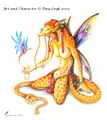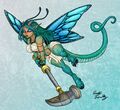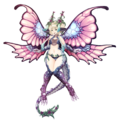Faerie Dragon

Faerie Dragons are one of the two oldest breeds of dragonet in Dungeons & Dragons, and probably the most recognizable. Small, playful and whimsical dragons with mysterious connections to the fey - emphasized by their having "fairy-like" butterfly-style wings, faerie dragons look weirdly like the result of crossbreeding a pseudodragon with a pixie and have an iconic visual. They are said to be incredibly popular with gamers for combining the visual and personality appeal of both miniature dragons and fairies in one package.
History[edit | edit source]
Faerie Dragons first appeared in issue #62 of Dragon Magazine, before receiving an upgrade to the Monster Manual II - this was during the days of Advanced Dungeons & Dragons 1st edition.
They were subsequently updated to AD&D 2e in the Monstrous Compendium Forgotten Realms Appendix, before moving to the Monstrous Manual alongside their Pseudodragon and Firedrake kinsfolk for the same edition - it was here that they gained their collective family name, "Dragonet", although that would be lost come the next edition.
It's possible that faerie dragons may have found their audience by virtue of appearing in the last officially aired episode of the D&D Cartoon, in which the heroes were instrumental in helping a clan of faerie dragons escape to a new home whilst evading a greedy lord out to steal the clan's treasure hoard.
In 3e, the Faerie Dragon began a years-long descent into obscurity. Whilst the Tome of of Horrors strove to include the faerie dragon amongst its many old-school beasties, it wasn't until the release of the Draconomicon that it made its official debut.
4e continued this; faerie dragons didn't appear until the first of its Draconomicon sourcebooks, where they were one of three breeds of Feywild Dragon covered in the Chromatic Draconomicon.
Come 5th edition, and this long slide was finally arrested; Faerie Dragons returned to the first Monster Manual of the edition, right alongside their Pseudodragon cousins.
Through The Ages[edit | edit source]
Like all creatures of Dungeons & Dragons, whilst the broad outline of the faerie dragon as a forest-dwelling, fey-like prankster and goodhearted mischief-maker has remained consistent, other details have varied depending on the edition.
AD&D[edit | edit source]
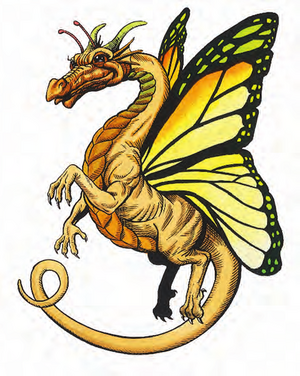
The Faery Dragon first appeared in the 1e AD&D Monster Manual II, where it's habitat and powers were first established.
The master version of the Faerie Dragon for 2nd edition appeared in the 1993 Monstrous Compendium. Here, it was described as a chaotic offshoot of the pseudodragon that dwells in peaceful, tangled forests. Though capable flyers, they are also fond of swimming and diving, and usually establish lairs in hollow trees near ponds or streams. Able to speak sylvan and animal tongues, they often live side-by-side with clans of sprites and pixies, and are usually on good terms with any neighboring elf clans.
They aren't necessarily welcomed by other races, because they are incurable pranksters. These dragonets live to make mischief on any humanoid creature that passes through their territories, often enlisting animals or fey to help in their pranks; these can range from spontaneous tricks to months-long, elaborately planned, spectacular jokes. The tell-tale giggle of the faerie dragon, reminiscent of tiny silver bells tinkling, is a key warning sign of their presence in an area.
These dragonets are unique in that they are herbivores, feeding on fruit, vegetables, nuts, roots and grains. They have a sweet tooth, however, and whilst they readily gorge themselves on honey when they find it in the wild, they are nuts for the fruit pastries that only humanoids can make. A faerie dragon will go to great lengths in the name of a fresh apple pie.
Females and males are distinguished by the tinge of their scales - golden for females, silver for males - but their actual color changes as they live; faerie dragons are the only dragonets to use the same draconic age categories as the true dragons.
This implicitly makes them the longest lived dragonets of all - the pseudodragon, by comparison, only lives 10 to 15 years. It certainly makes them the most magical. Able to become invisible at will, they also possess a unique breath weapon and natural spell-casting abilities - 65% of all faerie dragons have wizardly spells, whilst the remaining 35% have clerical spells drawn from the Spheres of Animal, Plant, Elemental and Weather. Though they have the rare ability to attack in any way, physically or mystically, without breaking their invisibility, faerie dragons are neither malevolent nor aggressive by nature; most of their spells are chosen for mischief-making or utilitarian purposes.
The spells that faerie dragons favor include water breathing, legend lore, ventriloquism, unseen servant, forget, suggestion, distance distortion, limited wish, obscurement, animal growth, and animate rock.
That said, whilst non-violent by nature, faerie dragons will defend themselves, and their companions amongst the local faeries and animals will usually swiftly join in on the fray.
A Hatchling faerie dragon is Red, has 10% Magic Resistance, and the spellcasting abilities of a 1st level caster, regardless of its affinity for arcane or divine spells.
A Very Young faerie dragon is Red-Orange, with 16% Magic Resistance, and the spellcasting abilities of either a 2nd level wizard or a 3rd level cleric.
A Young faerie dragon is Orange, with 24% Magic Resistance and the spellcasting abilities of either a 3rd level wizard or a 4th level cleric.
A Juvenile faerie dragon is Orange-Yellow, with 32% Magic Resistance and the spellcasting abilities of either a 4th level wizard or a 6th level cleric.
A Young Adult faerie dragon is Yellow, with 40% Magic Resistance and the spellcasting abilities of either a 5th level wizard or a 7th level cleric.
An Adult faerie dragon is Yellow, with 48% Magic Resistance and the spellcasting abilities of either a 6th level wizard or an 8th level cleric.
A Mature Adult faerie dragon is Green, with 56% Magic Resistance and the spellcasting abilities of either a 7th level level wizard or a 9th level cleric.
An Old faerie dragon is Blue-Green, with 64% Magic Resistance and the spellcasting abilities of either an 8th level wizard or a 10th level cleric.
A Very Old faerie dragon is Blue, with 72% Magic Resistance and the spellcasting abilities of either a 10th level wizard or a 11th level cleric.
A Venerable faerie dragon is Blue-Violet, with 80% Magic Resistance and the spellcasting abilities of either a 12th level wizard or a 12th level cleric.
A Wyrm faerie dragon is Violet, with 88% Magic Resistance and the spellcasting abilities of either a 14th level wizard or a 13th level cleric.
A Great Wyrm faerie dragon is Black, with 96% Magic Resistance and the spellcasting abilities of either a 16th level wizard or a 14th level cleric.
Regardless of age, all faerie dragons have the same breath weapon; a 2ft diameter cloud of euphoria gas that can leave a victim overwhelmed with bliss for 3d4 minutes. During this time, the target can't fight back at all, being unable to make attacks and suffering a -2 penalty to armor class, although they can try and remain focused on what's happening around them with a second saving throw.
3rd Edition[edit | edit source]
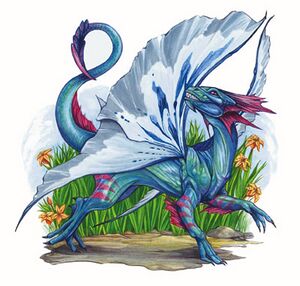
Faerie dragons are mentioned on page 158 of the Draconomicon. With a minimum of 8 hit dice and a level adjustment of +2, they are much more powerful than pseudodragons. Their mischievous personality remains intact, as does their affinity for the fey of the forests they inhabit, but 3e faerie dragons are quite different.
In this edition, they lose their Age Categories. Instead, all faerie dragons possess iridescent scales that reflect all the colors of the rainbow, contrasting beautiful metallic-platinum butterfly-like wings. They are more willing to flee battle than fight, although they often lead pursuers to more dangerous fey like dryads and nymphs if they're unwise enough to follow.
The 3e faerie dragon is much more aquatic in nature, gaining a natural affinity for the Swim skill and the innate ability to breathe water. Its euphoria gas breath weapon remains present, although now it simply dazes for 1d6 rounds, making it far less powerful.
Though having divine spell casting, they favor a large array of spell-like abilities that are used with a caster level of 12th: dancing lights, detect magic and ghost sound at-will; charm monster, entangle, glitterdust, major image and obscuring mist 3/day; animate objects, mind fog, project image and summon nature's ally IV 1/day; and finally commune with nature 1/month.
4th Edition[edit | edit source]
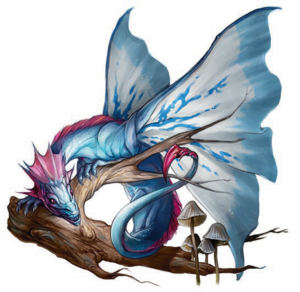
Ironically, the 4th edition version of the faerie dragon follows in the steps of its 3rd edition predecessor. Iridescent, dog-sized dragonets native to the Feywild, they are playful, mischievous creatures that simply seek to enjoy themselves and have fun.
Of all the Planar Dragons tied to the Feywild, they are believed to be the "purest", in that it's commonly supposed that they came into being spontaneously as a planar "echo" of the Chromatic Dragon and Metallic Dragon families of the Prime Material. This stands in stark contrast to their counterparts, the Mirage Dragon (evolved from migrant Green Dragons) and the Wretch Dragon (warped from Purple Dragon stock by the Fomorians).
As with all depictions of the faerie dragon, they would sing, play, flit about lazily, tell jokes and would rather play pranks than fight. They usually prefer to evade attackers or lead them to more violent fey, such as dryads and satyrs. When roused to fight, they are not especially powerful threats; neither of the Faerie Dragon statblocks in the Chromatic Draconomicon is higher than 4th level.
One thing that has changed is their breath weapon; in this edition it does Radiant elemental damage and allows the faerie dragon to teleport 1 square for each enemy caught in the effect. However, it can only use it once per encounter.
5th Edition[edit | edit source]
Having returned in the 5e Monster Manual at long last, the 5e depiction of the Faerie Dragon, like most other 5e monsters, goes back to its roots. Just, in a simplified format.
Now, the faerie dragon's age categories and attended color spectrum goes Red-Orange-Yellow-Green-Blue-Indigo-Violet, and each category above Red gives it a new 1/day spell-like ability, as follows:
- Red: Dancing Lights, Mage Hand, Minor Illusion (1/day for each)
- Orange: Color Spray
- Yellow: Mirror Image
- Green: Suggestion
- Blue: Major Image
- Indigo: Hallucinatory Terrain
- Violet: Polymorph
There are not, and there have never been, ultraviolet faerie dragons. To speculate otherwise is treason. Treason is punishable by death.
Faerie Dragons in 5e are Red until their 6th year, when they turn Orange for the next 5 years. After reaching the Yellow stage, they change colors once every 10 years until they reach Violet at the age of 51.
Also, whilst it has returned to its euphoria breath, it now only targets one creature with it per attack.
Personality-wise, it remains all but identical to its AD&D depiction - and, in fairness, it's not like its personality ever changed much in any of the editions before now. They do respond well to bribery in the form of sweets, baked goods and baubles, though.
Other Media[edit | edit source]

Faerie Dragons based on the D&D model have also appeared in Pathfinder (Bestiary 3) and in Warcraft. Not to mention in Heroes of Might and Magic.
Pathfinder Faerie Dragons are not true dragons, meaning they don't gain power with age (though they do typically take Sorcerer levels), that act more like prankster Fey. They are an option to take as an Improved Familiar and are notable among those for having innate spellcasting ability, which opens up some fun options.
Faerie Dragons also pop up in the Warcraft universe. In the strategy games, they were the Night Elves' mage killers, able to blow up enemy mages the moment they cast a spell in proximity. In World of Warcraft, they lose these unique properties and their portrayal is pretty much copy-pasted from D&D, some able to polymorph enemies. There are even 'fey drakes' that are so big they can be used as mounts, though a horse-sized faerie dragon looks about as silly as you would expect.
Gallery[edit | edit source]
-
Dragon Magazine #62
-
Dragon Magazine #62
-
5e
-
When kobold experiments in draconic emulation don't quite work out.
-
Well, they are technically True Dragons...
-
When you consider the reputation of both dragons and pixies, less weird than you'd think.
-
Sometimes, that wizard/familiar bond gets a little too close.
| The Dragons of Dungeons & Dragons | |
|---|---|
| Dragons | Albino Wyrm - Arcane Dragon - Aquatic Dragon - Brine Dragon - Catastrophic Dragon - Cerilian Dragon - Chromatic Dragon - Cloud Dragon - Cobra Dragon - Crimson Dragon - Deep Dragon - Dragonet - Epic Dragon - Faerie Dragon - Fang Dragon - Ferrous Dragon - Gem Dragon - Half-Dragon - Linnorm - Metallic Dragon - Minidragon - Mist Dragon - Moon Dragon - Obsidian Dragon - Oriental Dragon - Planar Dragon - Prismatic Dragon - Pseudodragon - Radiant Dragon - Red Hawk Dragon - Sand Dragon - Sea Wyrm - Shadow Dragon - Song Dragon - Stellar Dragon - Stone Dragon - Sun Dragon - Dragon Turtle |



